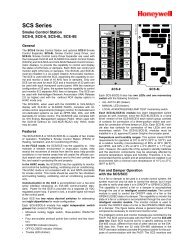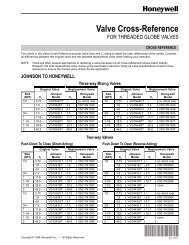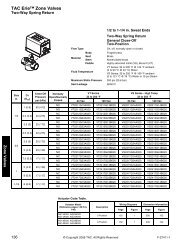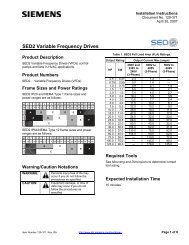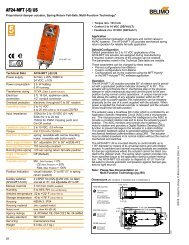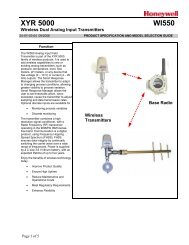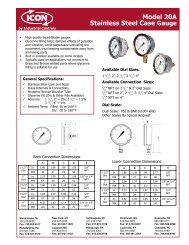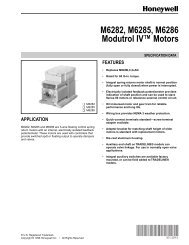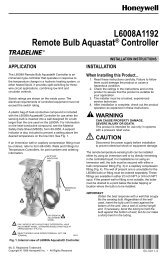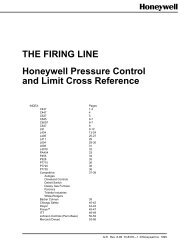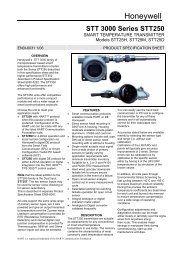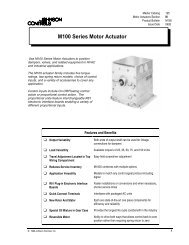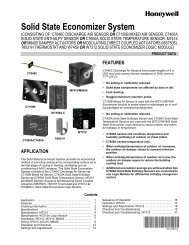Hancock 1500, 2500 and 4500 Pound Forged ... - Industrial Controls
Hancock 1500, 2500 and 4500 Pound Forged ... - Industrial Controls
Hancock 1500, 2500 and 4500 Pound Forged ... - Industrial Controls
Create successful ePaper yourself
Turn your PDF publications into a flip-book with our unique Google optimized e-Paper software.
TABLE 2—Suggested Backseating TorquesTorque - Ft. Lbs. { ±0 }<strong>1500</strong> Class <strong>2500</strong> Class <strong>4500</strong> Class1/4 15 15 153/8 15 15 151/2 15 15 153/4 20 20 201 20 20 201-1/4 75 75 751-1/2 75 75 752 75 75 75Valve SizeTABLE 3—Suggested Seating TorquesTorque - Ft. Lbs.{ +25% }Valve Size-0<strong>1500</strong> Class <strong>2500</strong> Class <strong>4500</strong> Class1/4 25 25 303/8 25 25 301/2 25 25 303/4 30 35 601 30 35 601-1/4 100 150 2001-1/2 100 150 2002 100 150 200If the valve is leaking when properly torqued,opening the valve <strong>and</strong> reclosing mayflush out foreign material trapped onthe seats. Do not use a wrench toclose the valve. If the valve will notshut off tightly when seating surfacesare free of foreign material, refinishingof the seat <strong>and</strong> disc is indicated.close valveD. H<strong>and</strong>ling<strong>Hancock</strong>/Yarway Tee Pattern/Angle Valves aredurable <strong>and</strong> rugged, <strong>and</strong> require no special h<strong>and</strong>ling.E. Storage! ATTENTIONDo not exceed specifiedtorques, or use a wrench toIndoor storage of valves is recommended, however,if prolonged storage is inticipated, the valvesshould be stored in a humidity controlled storagearea. The end protectors on the valves should betightly in position to prevent contamination <strong>and</strong>should remain in place until immediately prior toinstallation in the line. Further, gl<strong>and</strong> nuts shouldonly be h<strong>and</strong> tight during storage.If valves are ordered to a more stringent cleaning<strong>and</strong> storage procedure, the recommendations inthat procedure should be followed.F. Pre-installationPrior to installation, the following steps should betaken:1. Leave end protectors in place until readyfor installation, then remove.2. Inspect both ports for obstruction or foreignmaterials. Clean when necessary.3. Valves are shipped with the gl<strong>and</strong> nuts loose.These nuts must be tightened ! ATTENTIONbefore putting the valve in service.Operate the valve to determinewhether the packing gl<strong>and</strong>nuts are tight, a firm dragbetween the stem <strong>and</strong> the packingshould be felt. If necessary,Tighten gl<strong>and</strong> nuts beforeplacing valve in service.retighten the gl<strong>and</strong> nuts until the drag is firm.4. If packing is not installed in the valve, refer tothe Maintenance instructions (Section 4.L) inthis manual for packing installation directions.G. WeldingThese valves should be in the midopenposition prior to welding. Careshould be taken not to ground thevalve yoke, stem or the tee h<strong>and</strong>le.Maintain 350°F interpass temperaturerequirement when installing stainlesssteel valves.H. InstallationThe Tee Pattern Globe/Angle Valvemay be installed with the stem in positionrelative to the horizontal or verticalplane. However, the flow path asmarked by the arrow on the body Ensure that arrow on globevalve points in same directionas normal flowmust be maintained.After the valve is welded in line, the packing gl<strong>and</strong>nuts should be tightened. Further, after the systemstart up, <strong>and</strong> when the valve has reached itsexpected operating temperature, the gl<strong>and</strong> nutsshould be checked <strong>and</strong> adjusted as necessary toensure proper tightness. This precaution is due topossible loss of packing vloume from “off gasing” oflubricants <strong>and</strong> impurities in the packing.I. Packing Leakage! ATTENTIONDo not ground to yoke, stem ortee h<strong>and</strong>le when welding.! ATTENTIONIf packing leakage is discovered early <strong>and</strong> it is notsevere, nor is severe stem pitting present, leakagemay be stopped by tightening the packing gl<strong>and</strong>nuts. Tighten the nuts by rotating them clockwise,alternating 1/2 turn on each nut. Using an alternatetightening sequence will help insure that the gl<strong>and</strong>does not cock <strong>and</strong> bind stem. If leakage stops aftertightening, rotate the stem clockwise or counterclockwise1’2 turn using the valve tee h<strong>and</strong>le. If thepacking load required to stop leakage causes stembinding, this indicates that severe stem pitting, or5



